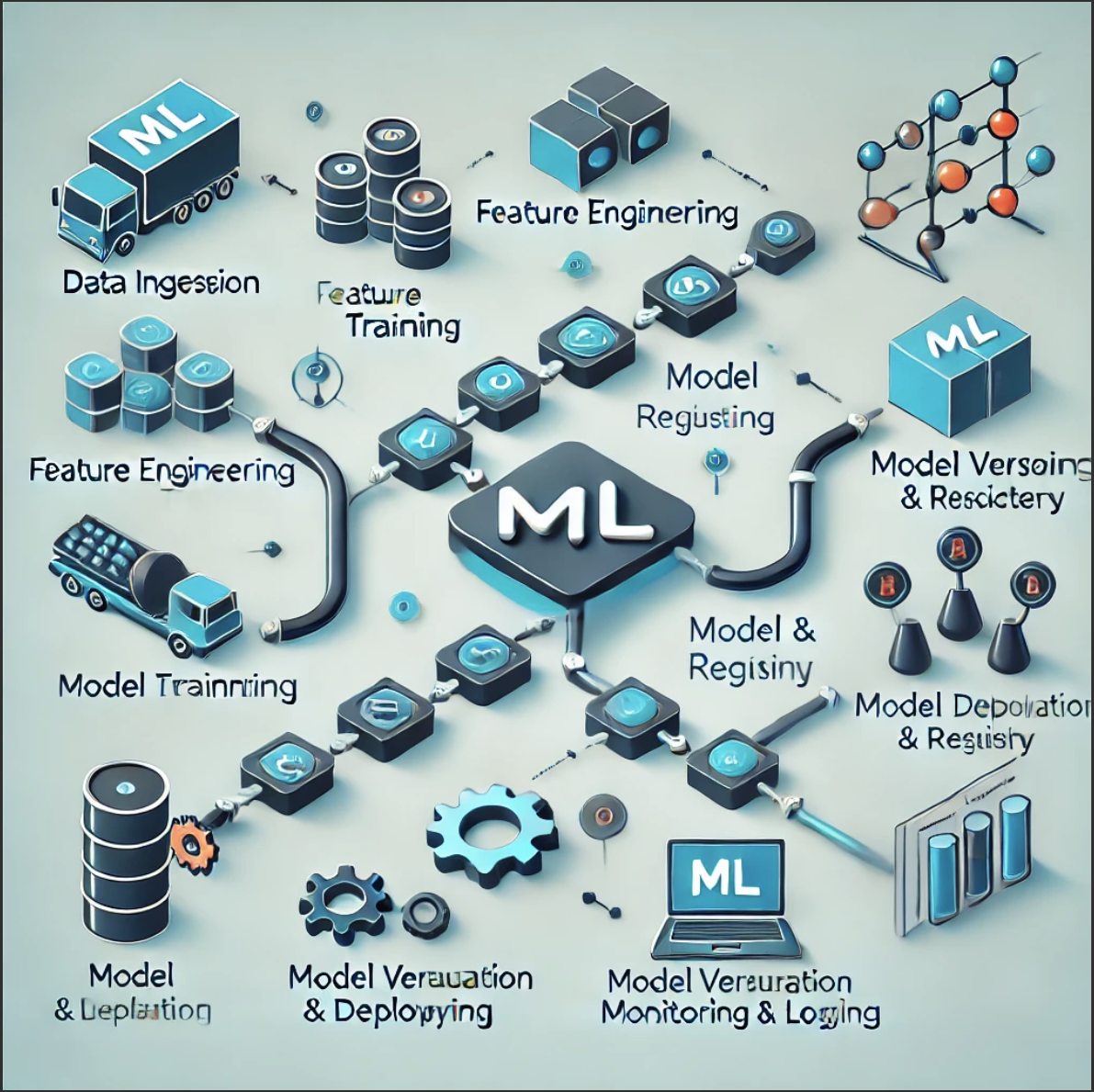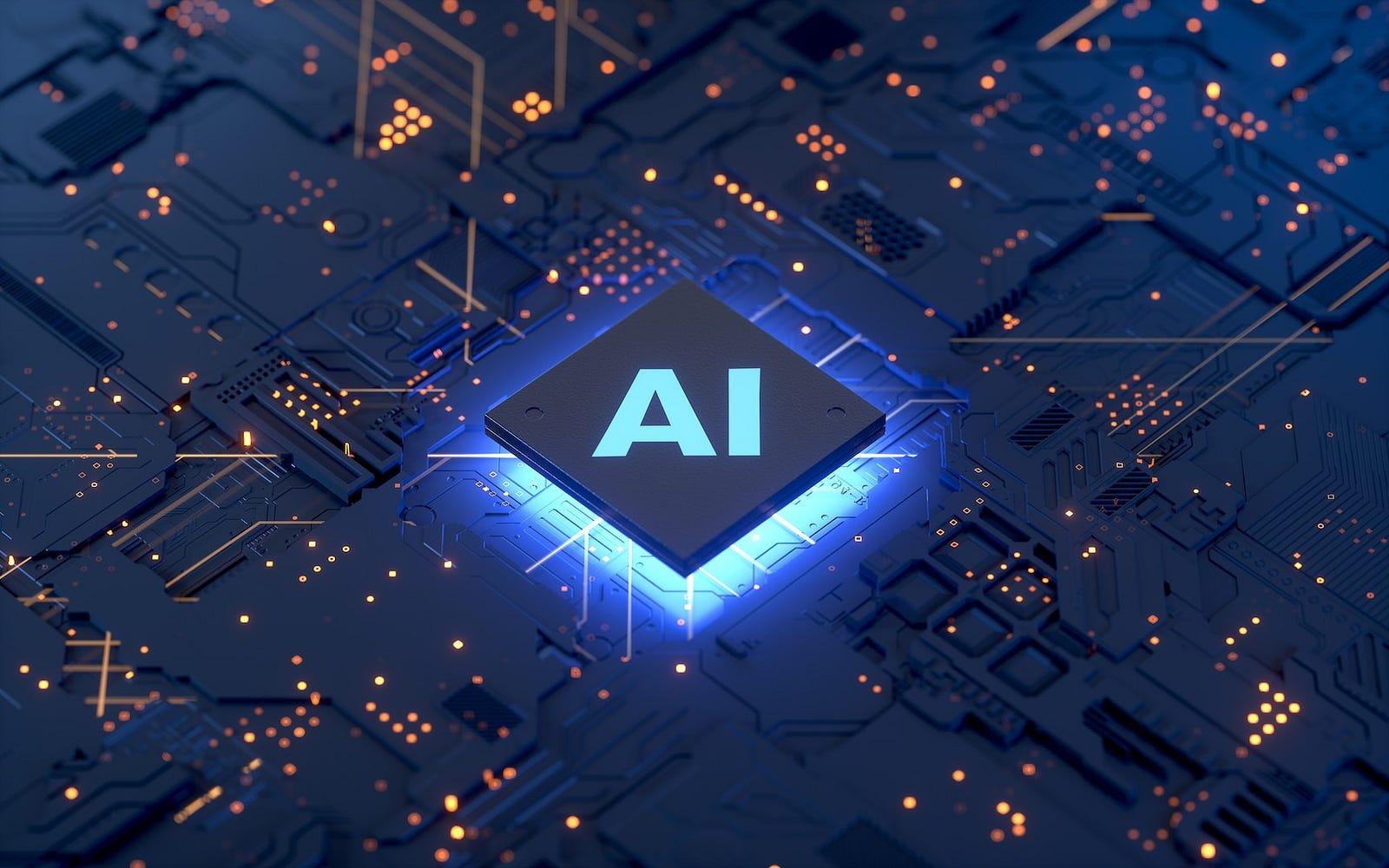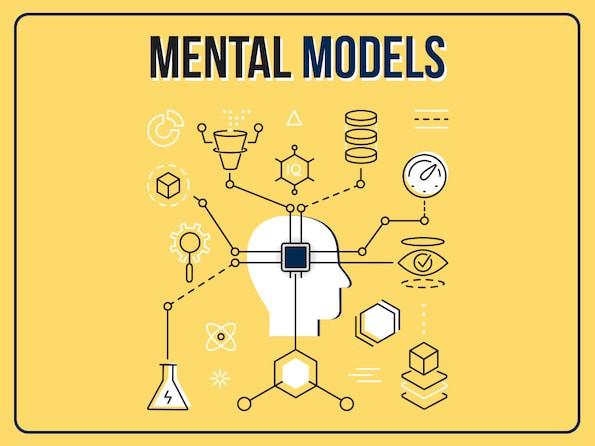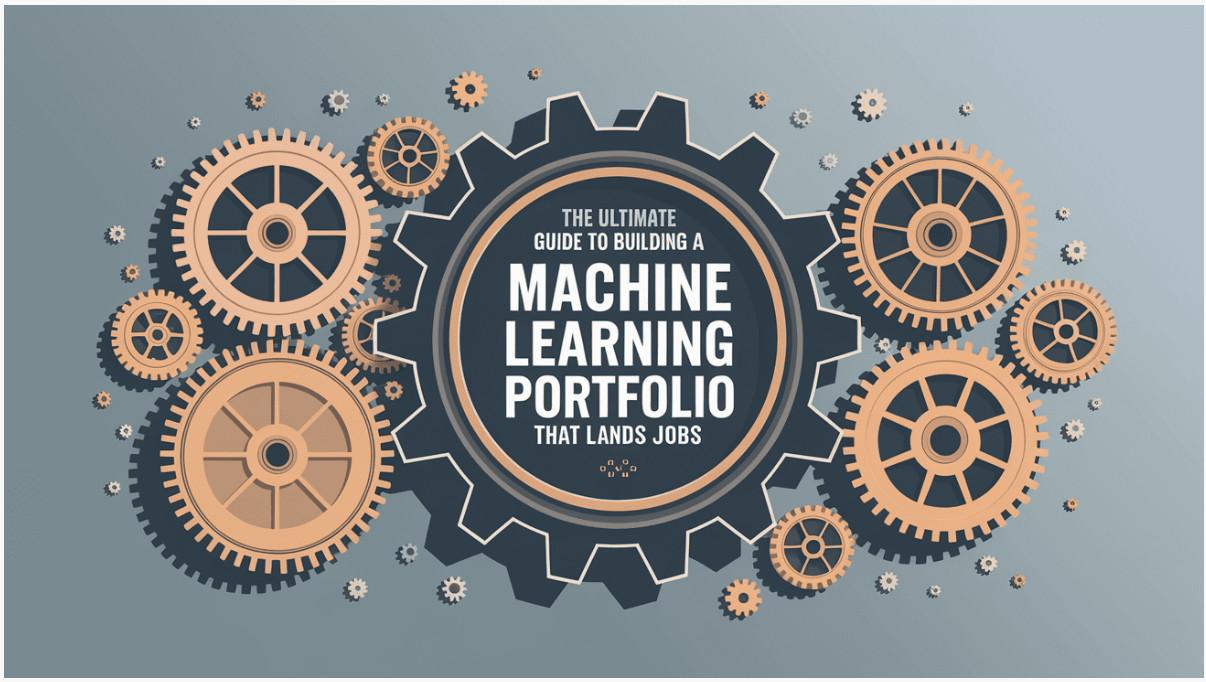Section 1: Introduction - Why “End-to-End” Thinking Is the Real Interview Superpower
There’s a point in every ML engineer’s career when coding alone stops being enough.
You’ve mastered the models, you can explain random forests and neural nets in your sleep, but when the interviewer leans in and asks:
“So, how would you take this model into production?”
…you pause.
That pause is where good candidates become average, and great ones stand out.
Because modern machine learning interviews aren’t just about modeling accuracy anymore, they’re about system thinking, deployment maturity, and your ability to connect technical solutions to real-world impact.
The Shift: From Model-Centric to Product-Centric Interviews
Until a few years ago, most ML interviews revolved around algorithms, probability, and math-heavy reasoning.
But as the ML ecosystem evolved, with models becoming easier to train but harder to operationalize, companies like Google, Amazon, and Anthropic began prioritizing candidates who understand end-to-end ML pipelines.
Today’s interviewers want to know:
- Can you frame a business problem as an ML task?
- Can you design a reproducible data pipeline?
- Can you monitor, retrain, and deploy models reliably?
- Can you collaborate with product and infrastructure teams?
If your answer to these is yes and you can explain how in detail, you’re already ahead of 80% of the candidate pool.
Why ML Engineers Need to Think Like Product Engineers
Interviewers are no longer impressed by Kaggle scores or offline benchmarks.
They care about engineers who can translate models into value-delivering systems.
When you explain your ML experience in terms of pipelines, not projects, you show:
- Systems mindset: You understand dependencies, data flow, and failure modes.
- Scalability awareness: You know how to handle latency, monitoring, and retraining.
- Collaboration ability: You can align with data engineers, product managers, and DevOps.
In short, you don’t just train models, you ship them.
And that’s exactly what companies mean when they say they want “ML engineers, not data scientists.”
What “End-to-End” Really Means (and Why Candidates Get It Wrong)
When candidates say “I’ve built an end-to-end ML project,” interviewers often ask:
“Can you describe the pipeline components?”
That’s where many stumble.
They describe the model training process, maybe mention preprocessing or APIs, but skip the glue that makes it a system, not a script.
True end-to-end understanding covers five key layers:
- Data Ingestion and Validation: Where and how data enters the system.
- Feature Engineering and Storage: Transformations, pipelines, and reproducibility.
- Model Training and Evaluation: Continuous experimentation with versioning.
- Deployment and Serving: Scalable, low-latency inference setups.
- Monitoring and Retraining: Detecting drift, automating retraining, and feedback loops.
In interviews, being able to speak to each layer clearly, with technical specificity, sets you apart instantly.
Example: How a Top Candidate Explains an ML Pipeline
Let’s say you’re asked:
“Tell me about an end-to-end ML project you’ve worked on.”
A weak answer might sound like this:
“I built a model to predict customer churn using XGBoost and achieved 87% accuracy.”
A strong answer sounds like this:
“I led an end-to-end churn prediction system where we ingested daily user engagement data via Apache Airflow, transformed features using Spark, stored intermediate datasets in S3, and versioned models with MLflow.
The model was deployed via AWS SageMaker for real-time inference, with automated monitoring for drift detection and retraining every two weeks.”
Notice the difference?
The first answer is a project summary.
The second is an engineering narrative.
It demonstrates mastery of data, models, and deployment infrastructure, all while keeping the focus on business value and system health.
That’s exactly what ML interviewers at FAANG and top startups want to hear.
The InterviewNode Approach: From Projects to Pipelines
At InterviewNode, we’ve found that the highest-performing ML candidates share a common trait, they stop seeing interviews as coding puzzles and start seeing them as opportunities to demonstrate ownership of the entire ML lifecycle.
Our top candidates reframe every technical question into a system narrative:
- “Here’s how I’d structure the data flow…”
- “Here’s how I’d monitor for data drift…”
- “Here’s how I’d ensure scalability when traffic spikes.”
That’s not memorization, that’s product thinking, and it’s the difference between passing an interview and acing it.
For deeper insight into this mindset shift, check out Interview Node’s guide “Mastering ML Interviews: Match Skills to Roles”, where we explore how aligning your technical focus with business outcomes dramatically increases your success rate.
In 2025, “End-to-End” Is the New “Algorithmic Mastery”
The ML landscape is changing fast. Tools like Vertex AI, SageMaker, and Databricks are automating the modeling layer, meaning the next frontier for engineers is operational maturity.
If you can confidently walk into an interview and explain how data flows from source to product, you’ll stand out, not just as a candidate who knows ML, but as one who knows how to make ML work in the real world.
And that’s the kind of engineer every team wants.
Section 2: Breaking Down the End-to-End ML Pipeline (Explaining Each Stage Clearly in Interviews)
If there’s one question that separates a mid-level ML engineer from a senior one, it’s this:
“Can you walk me through an end-to-end ML pipeline you’ve built or would design for this problem?”
This single prompt often determines whether a candidate advances.
Why? Because it tests not only your modeling skill but also your understanding of the ML ecosystem, how data, models, infrastructure, and monitoring interact to produce reliable predictions in production.
To answer this effectively, you need to break down the process into clear, modular components that reflect how ML systems actually work in the real world.
a. Data Ingestion and Validation - “The Foundation Layer”
Before models come data, and data quality determines everything downstream.
When explaining this stage in an interview, your goal is to show you understand:
- Where data comes from (e.g., APIs, databases, event streams like Kafka)
- How it’s ingested (batch vs. streaming pipelines)
- How you ensure data reliability (validation, schema checks, anomaly detection)
A strong interview answer might sound like:
“We used Apache Airflow for scheduled data ingestion from transactional databases into a data lake. I implemented validation checks with Great Expectations to ensure schema consistency and detect anomalies before feature extraction.”
That one sentence communicates ownership, tool fluency, and data integrity awareness, three key evaluation factors.
b. Feature Engineering and Transformation - “Turning Data Into Signal”
This is where you demonstrate both creativity and reproducibility.
Interviewers want to know:
- How do you design features that capture business logic?
- How do you handle transformations efficiently?
- How do you ensure feature consistency between training and production?
Best way to structure your explanation:
- Describe what you engineered:
“We created temporal features from user activity logs, session frequency, dwell time, and recency-based metrics.”
2. Explain why:
“These features captured engagement behavior, which correlated strongly with churn risk.”
3. Mention reproducibility:
“We used TFX’s Feature Store to standardize transformations between training and serving.”
That last part, feature store awareness, often distinguishes advanced candidates from project-based learners.
c. Model Training and Experimentation - “The Intelligence Layer”
Here’s where many candidates over-focus, diving into algorithms and hyperparameters.
But top interviewers care more about your training architecture, reproducibility, and evaluation discipline.
Key talking points:
- How you split data and prevent leakage
- How you track experiments (e.g., MLflow, Weights & Biases)
- How you evaluate metrics relative to the business goal
Example:
“We used MLflow for experiment tracking and versioned both code and data.
Our training pipeline ran on Kubernetes, and we used stratified cross-validation to stabilize metrics. Since false negatives were costlier, we optimized for recall instead of accuracy.”
This shows end-to-end awareness, that you don’t just train models, you manage experiments as products.
d. Model Deployment and Serving - “Where Models Meet Reality”
This is the part most candidates stumble on, and where interviewers pay the most attention.
You should be able to articulate:
- The deployment method (batch, real-time, or hybrid)
- The serving infrastructure (SageMaker, Vertex AI, custom APIs, etc.)
- How you handle versioning, rollback, and latency
Example:
“We deployed models through AWS SageMaker endpoints with auto-scaling enabled. To ensure smooth rollouts, we used blue-green deployment with a canary strategy to monitor metrics before full release.”
Bonus: mention how you integrated with product systems:
“Predictions were served via REST API into the customer engagement platform, updating recommendations in real time.”
That one line ties ML ops with product experience, the golden ticket in FAANG interviews.
e. Monitoring, Drift Detection, and Retraining - “The Lifeline Layer”
Interviewers love this topic because it separates theoretical ML knowledge from production reality.
Show that you understand that ML models decay, and that maintenance is as important as training.
Key points to mention:
- Monitoring for prediction drift and data drift
- Setting up alerts (e.g., via Prometheus, Grafana, or custom dashboards)
- Automating retraining triggers
Example:
“We tracked data distribution metrics daily using EvidentlyAI and built alerts for feature drift. When drift exceeded a set threshold, our Airflow DAG triggered retraining with the latest data snapshot.”
That’s a textbook-perfect answer, demonstrating ownership, automation, and operational excellence.
f. Post-Deployment Evaluation and Feedback Loop - “Closing the Circle”
Most candidates stop after deployment, great candidates don’t.
Show that you think about the feedback loop that keeps models improving.
Example:
“We periodically collected real user outcomes from the product logs to validate model predictions and fine-tune thresholds.
This feedback pipeline ensured our model performance aligned with evolving user behavior.”
Interviewers will immediately recognize this as a sign of maturity, someone who thinks like an ML product owner, not just an ML developer.
Pro Tip: Visualize the Flow During Your Answer
If you’re in a whiteboard or virtual setting, sketch your explanation.
A simple diagram with labeled arrows, data → features → model → deployment → feedback, can make your reasoning instantly clear.
Don’t underestimate the power of visual communication in ML interviews. It helps interviewers remember you, and it turns abstract reasoning into visible understanding.
Connecting It Back to Business Outcomes
Finally, always end your explanation by connecting the pipeline to business or user impact.
“The entire pipeline reduced churn by 8% month-over-month and automated 90% of the manual analysis work.”
That’s how you quantify engineering into value, a skill explored deeply in Interview Node’s guide “Quantifying Impact: How to Talk About Results in ML Interviews Like a Pro”.
Because in every great interview, clarity + context = confidence.
Section 3: How to Explain Your End-to-End ML Experience in Behavioral Interviews (Storytelling Framework)
Most ML engineers prepare for technical questions, coding, algorithms, modeling, but stumble when interviews shift to storytelling.
Questions like:
“Tell me about a time you deployed a model to production.”
“Describe a project that had measurable business impact.”
“What challenges did you face in maintaining an ML system?”
These aren’t casual questions, they’re designed to uncover how you think about ownership, collaboration, and productization.
And here’s the truth: you can have world-class technical skills, but if you can’t communicate end-to-end ownership, you’ll still lose offers to engineers who can.
Let’s fix that.
a. The Challenge of Explaining End-to-End ML Work
ML projects are inherently complex. They involve data pipelines, model experimentation, infrastructure orchestration, and product integration, often spread across multiple teams.
When asked to “describe your project,” many candidates:
- Overfocus on modeling algorithms
- Ramble through details without structure
- Forget to connect the work to product outcomes
The solution? Use a structured storytelling framework that simplifies complexity without dumbing it down.
b. The E2E Storytelling Framework (for ML Behavioral Rounds)
Here’s a framework that top InterviewNode candidates use to stand out in ML interviews:
C.A.R.M. Framework, Context, Action, Result, Maturity
It’s an evolution of the popular STAR format but tuned for technical storytelling in ML engineering interviews.
C → Context: Set the Stage
Start by framing the why: what problem were you solving, and what was at stake?
Keep it short but specific.
Example:
“At Meta, we noticed user retention on our recommendation platform was dropping. My team was tasked with designing an ML pipeline to predict disengagement risk and trigger personalized recommendations.”
This instantly positions you as a problem-solver aligned with business goals.
A → Action: Describe the End-to-End Work
Now, walk the interviewer through your pipeline design, touching each major component (data → features → model → deployment → monitoring).
Example:
“I led data ingestion via Airflow from multiple sources, implemented feature transformations in Spark, trained gradient boosting models on distributed clusters, and deployed them using Vertex AI.
To ensure reliability, I also implemented a feature store and monitoring system to catch drift in production.”
Keep it high-level yet detailed enough to show technical command.
💡 Tip: Anchor your explanation around systems, not scripts. Use words like “architecture,” “pipeline,” and “integration”, they convey scale and maturity.
R → Result: Quantify the Impact
Impact is the currency of behavioral interviews.
Even if you didn’t measure exact revenue, quantify improvements in metrics, efficiency, or stability.
Example:
“Our pipeline improved model retraining speed by 40%, reduced downtime by 60%, and increased retention predictions’ accuracy by 12%. The business saw a 7% improvement in user engagement.”
Specificity = credibility.
When you translate engineering work into measurable results, you sound like a leader, not just a contributor.
M → Maturity: Reflect on the Learnings
This is where most candidates miss a major opportunity.
Great engineers don’t just describe, they reflect.
Talk about what you’d do differently or how you applied lessons in later projects.
Example:
“One major learning was that feature versioning is critical, inconsistent transformations caused training/serving mismatches early on. I later standardized our feature pipeline using TFX and version control.”
This shows growth mindset, technical insight, and awareness, traits interviewers prize at FAANG.
c. Example: Turning a Complex Project Into a Compelling Story
Let’s walk through a realistic example using the C.A.R.M. framework.
Prompt:
“Tell me about an ML system you built end-to-end.”
✅ Strong Response:
“At Amazon, I worked on an ML pipeline for demand forecasting in supply chain optimization.
The challenge was scaling predictions across thousands of SKUs daily.
I designed a pipeline that ingested data from sales logs via AWS Glue, engineered temporal and seasonality features in PySpark, and trained LightGBM models on distributed nodes.
The models were deployed via SageMaker endpoints with real-time inference, and we used Grafana dashboards to monitor model drift.
The project reduced forecasting errors by 18%, saving millions in excess inventory.
A key learning was that monitoring needed to account for upstream data quality, we implemented schema validation to prevent silent failures in production.”
In less than two minutes, this answer communicates:
- Technical depth
- Pipeline ownership
- Business impact
- Reflection
It’s not just storytelling, it’s strategic communication.
d. Connect It to the Future of ML Hiring
FAANG interviews in 2025 increasingly emphasize engineers who can bridge research and production, those who turn ideas into scalable ML systems.
That’s why explaining end-to-end pipelines clearly isn’t just interview prep, it’s career branding.
You’re signaling that you’re not a model builder, you’re a machine learning systems thinker.
To reinforce this mindset, explore Interview Node’s guide “The Future of ML Hiring: Why Companies Are Shifting from LeetCode to Case Studies”, which dives deeper into this trend.
Section 4: Common Mistakes Candidates Make When Discussing ML Pipelines (and How to Avoid Them)
Even highly skilled machine learning engineers, the ones who’ve built real systems and worked on production-grade models, often fail to communicate their value effectively in interviews.
Not because they lack skill, but because they fail to translate engineering complexity into structured clarity.
Through thousands of mock interviews conducted by InterviewNode, we’ve seen clear patterns in where candidates lose ground.
Let’s break down those pitfalls, and exactly how to avoid them.
Mistake #1: Treating the ML Pipeline as Just “Model Training”
The most common trap: describing your entire project as if it begins and ends with model training.
You’ve probably heard something like this in interviews:
“I trained a model on X data, tuned hyperparameters, and got 90% accuracy.”
That’s not an end-to-end pipeline, that’s a Jupyter notebook exercise.
How to fix it:
Frame your response as a system, not a script.
Add context before and after modeling:
“I designed a pipeline where raw data was ingested via Kafka streams, transformed through Spark, and served predictions via a REST API. The model training was automated weekly using MLflow for tracking.”
That phrasing alone signals maturity and real-world deployment experience.
Mistake #2: Overloading on Technical Buzzwords Without Structure
Many engineers think that listing tools, Airflow, TFX, SageMaker, Docker, Kubernetes, makes them sound impressive.
It doesn’t.
Interviewers quickly see through “buzzword dumps.”
Example of a weak answer:
“We used Kafka, Spark, Docker, TensorFlow, Airflow, Kubernetes, and SageMaker.”
That’s like saying you used “a hammer, screwdriver, and wrench” without explaining what you built.
How to fix it:
Replace name-dropping with functional clarity.
Example:
“We used Airflow for pipeline orchestration, Spark for distributed transformations, and Dockerized the model for reproducible deployment via Kubernetes.”
Now, every tool has a purpose, and your narrative has flow.
Mistake #3: Ignoring the Data Layer
Most candidates start their story at “model training,” skipping over the data pipeline that powers everything.
Interviewers, especially at FAANG and top AI startups, care deeply about data quality, validation, and lineage.
How to fix it:
Always start your explanation from the data layer:
“The pipeline started with data ingestion through AWS Glue, where we performed schema validation and quality checks before transformation.”
Even if your project was small-scale, show awareness of how bad data breaks good models.
Mistake #4: Focusing on Accuracy Over Reliability
Candidates often emphasize model accuracy as the end-all metric, but interviewers care more about reliability, scalability, and maintenance.
In production, a 0.5% accuracy gain means nothing if your system fails under load.
How to fix it:
Discuss trade-offs and reliability measures:
“We optimized for latency and scalability by caching frequent predictions and containerizing the service. While accuracy stayed constant, inference time dropped by 45%.”
That shift in language communicates engineering maturity, not academic perfectionism.
Mistake #5: Forgetting Post-Deployment Maintenance
Most ML systems fail quietly after deployment, due to model drift, changing data distributions, or monitoring blind spots.
Yet, 70% of candidates forget to mention anything about post-deployment health.
How to fix it:
Always include a sentence about monitoring and retraining.
Example:
“We monitored data drift with EvidentlyAI, retraining the model monthly when prediction distributions diverged by over 10%.”
Even if it’s simulated or theoretical, this shows awareness of model lifecycle management, not just model training.
The Fix: Structured Clarity Beats Technical Volume
To summarize, the best ML pipeline discussions are:
- Structured (clear, modular flow)
- Impact-driven (tie technical work to results)
- Scalable (include deployment & monitoring)
- Reflective (show awareness of lessons learned)
As explored in Interview Node’s guide “The Hidden Metrics: How Interviewers Evaluate ML Thinking, Not Just Code”, FAANG interviewers now weigh clarity of reasoning just as heavily as raw technical skill.
So, the more clearly you explain your end-to-end ML pipeline, the more you let your thinking, not just your technology, shine.
🧩 Conclusion: Turning Your ML Experience into a Product Story
In 2025, the strongest ML interview candidates are no longer the ones who just know the algorithms, they’re the ones who can connect models to impact and systems to scalability.
When you talk about your work in terms of end-to-end ML pipelines, you’re not just describing what you built, you’re showing that you think like a machine learning product engineer.
You understand how data becomes intelligence.
You understand how that intelligence drives outcomes.
And, most importantly, you can explain that journey clearly, step by step.
That’s the skill FAANG interviewers, and top AI startups, are hunting for.
Here’s the bottom line:
In ML interviews, clarity is as valuable as accuracy, and product awareness is as critical as modeling skill.
By mastering this ability to discuss your pipeline from ingestion to monitoring, you’re not just prepping for an interview, you’re building your professional identity as a systems-minded ML engineer.
And when your interviewer leans back and says, “Walk me through how you’d productionize that,” you’ll smile, because you won’t just have an answer.
You’ll have a story.
💬 FAQs About Discussing End-to-End ML Pipelines in Interviews
1. How detailed should I go when describing my ML pipeline in an interview?
Aim for a balance between clarity and conciseness.
Use a structured flow, data → features → model → deployment → monitoring, and spend roughly 45 seconds per stage.
Avoid overloading with metrics or hyperparameters unless asked.
2. What if I’ve only done academic or personal ML projects, not production pipelines?
That’s fine!
Frame your explanation around best practices and hypothetical scalability improvements.
Example:
“In a production setting, I’d use Airflow for orchestration and feature stores to ensure consistency.”
Show awareness of how your project would evolve in a real environment, that’s what interviewers want to see.
3. How do I discuss collaboration if I worked mostly solo?
You can still highlight cross-functional thinking.
Example:
“While I developed this independently, I designed it assuming collaboration with data engineers and DevOps teams for deployment.”
Mentioning how you would integrate with others signals maturity and team readiness.
4. What’s the biggest mistake candidates make when discussing ML pipelines?
Over-indexing on the modeling stage.
Most candidates skip the data pipeline, orchestration, and monitoring, the parts that actually define real-world ML systems.
Always include how data flows, how results are consumed, and how feedback loops work.
For deeper guidance, see Interview Node’s guide “The Hidden Metrics: How Interviewers Evaluate ML Thinking, Not Just Code”.
5. Should I draw diagrams or rely on verbal explanations?
If possible, draw simple diagrams, even virtually.
A 3-box flow (Data → Model → API) can make your reasoning far clearer.
Interviewers remember visuals far more than monologues.
6. How do I handle gaps in my production experience?
Own them, and fill them with theoretical understanding.
Example:
“I haven’t deployed with Kubernetes yet, but I understand its role in container orchestration for scalable ML services.”
Interviewers respect curiosity and learning mindset more than buzzword familiarity.
7. What metrics should I emphasize when discussing pipeline results?
Focus on impact metrics, not just accuracy:
- Latency
- Uptime
- Data freshness
- Retraining automation
- Cost reduction
- Business outcomes (e.g., “reduced churn by 9%”)
These translate your engineering work into measurable value.
8. How do I describe monitoring and drift detection simply?
Use this one-liner:
“We monitored prediction drift daily using dashboards and triggered retraining when distributions shifted significantly.”
Mention tools like EvidentlyAI, Prometheus, or Grafana if you’ve used them, otherwise, focus on the concepts of drift and feedback loops.
9. How do I discuss data validation without sounding too technical?
Frame it in terms of risk prevention.
Example:
“We validated input schemas and missing values to ensure that bad data wouldn’t propagate into model predictions.”
That communicates reliability without jargon.
10. How do I tie my ML pipeline explanation to business outcomes?
Always end with an outcome sentence:
“This pipeline improved forecast reliability by 12% and reduced manual monitoring by half.”
If you don’t have exact figures, mention directional impact, “increased engagement,” “reduced latency,” etc.
11. What if I get interrupted while explaining my pipeline?
Stay calm.
Say:
“Sure, let me pause here. Would you like me to dive deeper into the modeling or deployment side?”
This shows you’re adaptable and collaborative, both are major FAANG evaluation criteria.
12. How can I make my answer memorable to interviewers?
Use structured language + one unique insight.
Example:
“One thing I’ve learned is that monitoring ML systems is more important than tuning them.”
That reflective insight helps you stand out, it shows depth and maturity beyond technical skill.
13. Should I mention tools like MLflow, Airflow, or SageMaker by name?
Yes, if you connect them to purpose.
Instead of:
“We used MLflow.”
Say:
“We tracked experiments with MLflow to ensure reproducibility and auditability across versions.”
Purposeful tool usage = professional credibility.
14. How do I handle questions about scaling or optimizing pipelines I’ve never worked on?
Think aloud logically.
Example:
“At scale, I’d likely parallelize feature extraction using Spark and leverage autoscaling for inference endpoints.”
Interviewers want to hear your reasoning, not your résumé.
For help mastering this technique, check out Interview Node’s guide “How to Think Aloud in ML Interviews: The Secret to Impressing Every Interviewer”.
15. What’s the best closing line when discussing an ML pipeline?
End confidently, with impact and reflection:
“This project taught me that ML success depends less on algorithms and more on data reliability and deployment discipline.
That’s why, in every new project, I start with the system, not the model.”
That statement does two things:
- It summarizes your entire approach elegantly.
- It leaves the interviewer with the impression of thoughtful leadership.
🚀 Final Thoughts
You can think of this skill, articulating an ML pipeline end-to-end, as the bridge between engineering and influence.
It’s how you prove you’re not just capable of building models, but of delivering value through them.
So the next time you sit down for an interview and someone says,
“Tell me about a machine learning system you’ve built,”
take a deep breath, smile, and walk them through your system, not as a coder, not as a data scientist, but as a product engineer who understands the entire ML lifecycle.
That’s the kind of answer that doesn’t just impress interviewers, it gets you hired.






